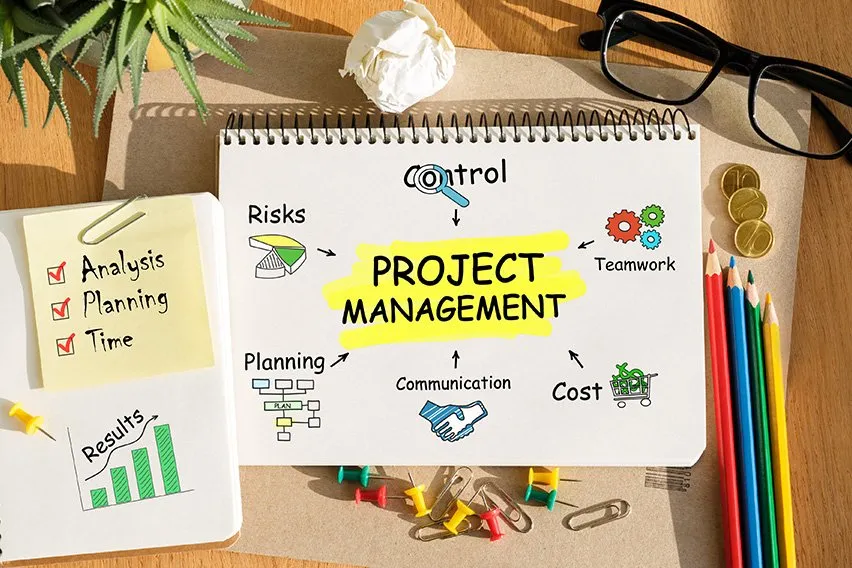What Are the Project Management Processes?

Project managers are tasked with launching and keeping the project on track from start to completion. Their job is to make everything run smoothly and collaborate with their teams and clients.
The project management process helps anyone leading a project, committee or team initiative for an organization. Whether you are organizing a small office party or leading a new product development initiative, project management tools and processes exist to increase success rate as a project manager.
Here are the five stages of the Project Process:
Step 1: Initiation
This is where your project begins. In this phase, the value and feasibility of the project are determined. Before the project is approved or rejected, two documents are created to sell the work to stakeholders and sponsors.
- Business Case: This is where you justify the need of the project including analyzing the return on investment.
- Feasibility Study: This is an evaluation of project goals, the timeline to completion and how much they who project will cost. Here is where you should also note what resources will be required to fulfill the project and clarify why and how it makes financial and business sense.
Step 2: Planning
Once the project is approved, the next step is to assemble a project team. However, project managers should first understand Tuckman’s stages of team development. These stages help project managers understand the team’s progression and dynamics. By recognizing these stages, managers can assemble the right project team and begin planning how to manage the project to achieve goals within budget and on time.
The project plan should include what financial and material resources are needed to complete the project.
Your plan should include:
- Scope: a written statement that reiterates the need for the project and its deliverables and objectives.
- Definition: break down of the larger deliverables into smaller ones.
- Tasks: tasks necessary to produce the deliverables and figure out if any tasks are dependent on other tasks.
- Schedule: Determine the duration of the tasks and set dates for their completion.
- Cost: Formulate a budget with the estimated costs involved across the project.
- Quality: Make sure the work being done is meeting quality objectives throughout the project.
- Organization: how will the project be organized and who do you have report progress to and get approvals from.
- Staff: determine the roles and responsibilities of your project team.
- Communications: decide how much project information will be communicated, to whom and how often.
- Risk: determine what risks are likely, how they’ll impact the project and how you plan to resolve them.
- Procurement: decide what work or materials will be contracted and who those contracts will go to.

Step 3: Execution
Now that planning is done, you’re ready to start the project. This is where things start moving along. This phase is made of these detailed processes.
- Executing the Plan: follow the plan you created, assign the tasks to team members and manage and monitor their progress with project management tools, like a project dashboard.
- Administrate: Manage the contracts secured in the project.
Step 4: Managing and Controlling
This step is to ensure that project you have planned is being actualized. All aspects of the project must be monitored and adjusted as needed. To do that, follow these processes.
Reporting: have a metric to measure project progress and an instrument to deliver this information.
- Scope: monitor scope and control changes.
- Quality: measure the quality of deliverables and make sure that the planned quality is being met. If not, evaluate how to improve quality.
- Schedule: keep track of delays or blocks that impact the timeline of the project and manage and adjust to stay on track.
- Cost: keep track of expenses and control cost changes.
- Risk: keep an eye out for changes in risk throughout the project and respond accordingly.
Step 5: Closing
Your project is not over once your goals and objectives have been met. The last phase is closing out and it involves these processes:
- Scope: checking to make sure all project deliverables have been completed as planned.
- Administration: close out all outstanding contracts and administrative matters, archive the paperwork and disseminate final information to relevant parties.
This article will also include information about:
How Do You Manage Processes?
Now that you’re on way to managing a project, here are a few tips to help you manage your processes to get your project to completion.
Define the Scope
The first and most important step in any project is defining the scope of the project. What is the project objective? What are you supposed to accomplish and create? It is as equally important to know what is not included in your scope. Get your boss to clearly define the scope of the project, if you are confused by any of the assigned objectives.
You might be tasked to plan a corporate social function. The scope of the project would be organizing a reception for 100 guests complete with dinner, open bar and entertainment by a certain date at a cost not exceeding $20,000.
Determine Available Resources
You will have to deal with management to make sure you have the people, equipment and money available to achieve the project objectives. As a project manager, you won’t have direct control of these resources, but you can talk to your direct manager about it.
Understand the Timeline
As a project manager, knowing when a project needs to be completed is essential to your planning process. As you develop your project plan you might find that you have some flexibility with how you use your time during a project. However, some deadlines – like event deadlines – are fixed. If you decide to use overtime hours to meet your schedule, you must weigh those hours against what you can afford within your budget.
Assemble Your Team
Your team is made up with technical experts chosen to complete the project at hand. Getting your team together will help you start a dialog about the next steps and any concerns they might have. Their functional manager assigned them to the team and your job is to manage this team.
Detail the Work
What major pieces or components need to be created to complete the project? Each larger item can be broken down into additional tasks. Work with your team members to clarify out the details necessary to achieve each small task and large component. The person in charge of each task must make decisions based on what the options are, the cost and limitations. Under each large component of a project, list smaller tasks that help achieve the large component. How deep you go depends on the size and complexity of the project you are working on.
Develop a Preliminary Plan
A great way to start assembling your plan is to use a precedence table to identify what tasks need to happen before another task can proceed. Formal project management planning includes the practice of developing a network diagram and identifying a critical path. If you are new to project management, these terms might be unfamiliar to you. Basically, the core idea is to sequence the activities in the right order and then allocating resources for those activities.
Questions to ask include:
- What happens first?
- What happens next?
- Which steps can happen at the same time using different resources?
- How long will it take?
There are a lot of excellent software options that will automate a lot of these details for you. Ask fellow project managers what they use.

Create A Baseline Plan
Get feedback on your preliminary plan from your team and other stakeholders. With this feedback, adjust your timelines and work schedules to fit the project into the available time. Apply these changes to the preliminary plan to produce your baseline plan.
Reject Project Adjustments
Usually, there is never enough time, money and talent assigned to a project. As a project manager, your job is to do more with the limited resources than people expect. However, these restrictions might simply be unrealistic. In these cases, you need to make your case and present it your boss to request the unrealistic limits to be changed. If you can anticipate the problems ahead of time, you can ask for your changes at the beginning of the project. This will save you time and money compared to what would happen if you asked for these changes later in the project.
Work Through Your Plan But Don’t Die For It
While making a plan is important, it is also important to be prepared to change your plan if necessary. If one part of your plan is blocked by an accident, you need to change your plan and go a different way. Do the same with your project plan. Change things as needed but always keep the scope and resources.
Document Everything
Make sure you keep a paper trail and records of all the work you do. Every time you change your baseline, write down what the change was and why it was necessary. When you have a new requirement is added to a project write down where the requirement came from and how it impacts the timeline and budget. You won’t be able to remember everything, so writing it down helps you to look at everything at the end of the project so that you can learn from them and answer questions from managers.
Monitor Progress
Set everyone on your team with their expectations at the beginning of the project. After that, check in regularly to see their progress and to check if anything is getting in their way. This will make it easier to catch issues before they become a problem.
Keep Your Team Informed
Let all your project stakeholder know your project progression along the way. Let them know of your successes as you complete each milestone. Make sure to also inform them about problems as soon as they come up. Keep your team informed along the way too, so they can consider how changes being made will impact their tasks. Make sure everyone on the team knows how other people on their team is doing, in case they need to pitch in.
What Is a BPM Tool?
Business Process Management (BPM) tools are used for automating, measuring and optimizing business processes and project management. These tools allow project managers to secure resources they need to execute a plan, measure project activity and change and improve processes whenever possible.
BPM software tools let managers to create business process diagrams. Simple tools only support diagramming and store each model element in a database so that they can be reused on other diagrams or updated.
RELATED ARTICLES


 Why Is Project Management Important? Because It Provides a Detailed Plan
Why Is Project Management Important? Because It Provides a Detailed Plan 16 Tips on How To Organize a Business
16 Tips on How To Organize a Business Improve the Efficiency of Your Employees: 10 Proven Tips for Small Businesses
Improve the Efficiency of Your Employees: 10 Proven Tips for Small Businesses 15 Hacks for Improving Efficiency in the Workplace
15 Hacks for Improving Efficiency in the Workplace 7 Proven and Budget-Friendly Ideas to Improve Your Small Business
7 Proven and Budget-Friendly Ideas to Improve Your Small Business Top 8 Receipt Scanner App Picks to Track Expenses in 2025
Top 8 Receipt Scanner App Picks to Track Expenses in 2025